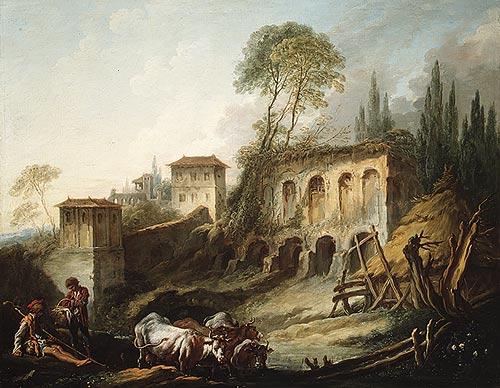-


 Francois Boucher
Francois Boucher
French
Artist
Francois Boucher was a French painter, a proponent of Rococo taste, known for his idyllic and voluptuous paintings on classical themes, decorative allegories representing the arts or pastoral occupations, intended as a sort of two-dimensional furniture. Francois Boucher also painted several portraits of his illustrious patroness, Madame de Pompadour. More than any other artist, François Boucher is associated with the formulation of the mature Rococo style and its dissemination throughout Europe.
Among the most prolific of his generation, he worked in virtually every medium and every genre, creating a personal idiom that found wide reproduction in print form. Francois Boucher was highly adept at marketing his work, providing designs for all manner of decorative arts, from porcelain to tapestry. Boucher's insistence on a painterly surface and adoption of a high-toned palette favoring blues and pinks was well suited to Rococo interiors, but was the target of critical derision late in his career when the style fell from favor. Denis Diderot, whose opinion on Boucher's merit was decidedly mixed, famously wrote of him in his review of the 1761 Salon, "Cet homme a tout—excepté la vérité" (That man is capable of everything—except the truth).
Francois Boucher, the son of a designer of lace, was born in Paris. He studied with the painter François Le Moyne but was most influenced by the delicate style of his contemporary Antoine Watteau. At the age of 17 the young Boucher was apprenticed by his father, a designer of embroidery patterns, to François Lemoyne. However, after only 3 months, Francois Boucher went to work for the engraver Jean-François Cars. Within 3 years François Boucher had already won the Grand Prix de Rome, although he did not take up the ensuing opportunity to study in Italy until 4 years later. On his return in 1731, Francois Boucher was admitted to the Academy as a historical painter, becoming a member in 1734.
Francois Boucher was the favorite painter of the Marquise de Pompadour, mistress of King Louis XV, whose name became synonymous with Rococo art, and it is in his portraits, particularly of her (shown top of page), that this style is clearly exemplified. Paintings such as "The Breakfast" of 1739 also show Boucher as a master of the genre scene in which he regularly used his own wife and family as models.
However, such intimate family scenes are in contrast to the libertine style as seen in his "Odalisque" portraits, the dark-haired version of which prompted Diderot to claim that Boucher was "prostituting his own wife", and the "Blonde Odalisque" (shown here) in which the extra-marital relationships of the King were evoked. Such private commissions for wealthy collectors gained Boucher his lasting notoriety and, after the censure of Diderot with his new morality, his final creative years his reputation came under increasing critical attack.
Francois Boucher was not only a painter, he also designed theatre costumes and sets, and the amorous intrigues of the comic operas of Favart involving shepherds and shepherdesses, closely parallel his own style of painting. Tapestry design was also a major activity, together with his design activities for the opera and the royal palaces of Versailles, Fontainebleu and Choisy, all of which augmented his earlier reputation, resulting in many engravings from his work and even reproduction of his themes onto porcelain and biscuit-ware at the Vincennes and Sèvres factories.
Boucher's impact on the decorative arts of the Rococo period, in France and throughout Europe, is difficult to overstate. Aside from the three dozen or so plates Francois Boucher etched himself, a great number of printmakers found it lucrative to reproduce his paintings and drawings; some 1,500 prints after Boucher are known today.